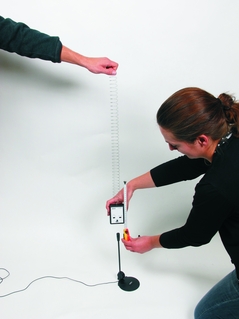Principle
When an ambulance passes by, the perceived (measured) signal of the siren becomes deeper. This means that the frequencies of the perceived sound become lower. This change in the perceived frequency of waves of all kinds, while the source and observer move relative to each other, is called the Doppler effect. The Doppler effect is used in numerous technical applications, such as in traffic radar traps or for determining the speed at which the universe is expanding.
In the preliminary experiment, the Doppler effect as it is known from everyday life is recalled to the students' mind in a qualitative manner based on an audible frequency, while the main experiment focuses on the case of a harmonically oscillating sound source. First, the frequency of the emitted signal is measured at rest. Then, the frequency shift that is caused by the oscillating Doppler transmitter is proved with the aid of the software. This is followed by the calculation of the velocity of movement of the sound source based on the experimental values. This calculated value is then compared to the theoretical value.
Benefits
- Experiment is part of an experiment set with a total of 22 experiments about generation, propagation and perception of sound, oscillations and waves
- Particularly appropriate as an experiment for first contact with physics in general
- With graphic student worksheets
- With detailed instructor information
- Optimized for tight schedules, i.e. minimum preparation time required
Tasks
- When the Doppler transmitter emits a sound of 4.6 kHz, move it very quickly to and fro and describe what you hear.
- Determine the velocity of an oscillating spring pendulum with the aid of the Doppler effect:
Let the Doppler transmitter with the 19 kHz signal oscillate harmonically above a microphone with the aid of a spring.
Analyse the signal that was recorded by a microphone with the aid of a computer. Observe the Doppler effect and determine the maximum velocity of the pendulum.
Learning objectives
- Frequency shift


